| Class 1: Explosives | |
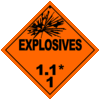 | Class 1.1: Substances which explode suddenly and explode in mass |
| It contains the explosives which can cause a mass explosion. An explosion instantly affects almost the entire load. | |
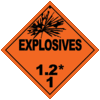 | Class 1.2: Substances which ejects a piece but not explode in mass |
| It contains the explosives which ejects a piece / a part but not explode in mass. | |
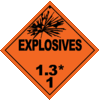 | Class 1.3: Flammable Explosives |
| It contains substances which have a fire hazard, or a minor risk of eject part but not a mass explosion hazard. | |
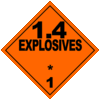 | Class 1.4: Low Harmful Explosives |
| It contains substances with risk of explosion of light intensity whose effects cannot go beyond its package and which can not cause an explosion or fire. | |
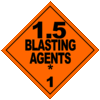 | Class 1.5: Difficult to explode but can explode in mass |
| It contains substances which can explode in mass but are very low sensitivity and difficult to explode. | |
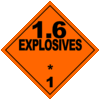 | Class 1.6: Difficult to explode and do not have a mass explosion hazard |
| It contains the substance which hardly explode, do not have a mass explosion hazard and very low sensitivity. | |
| Class 2 :Gases | |
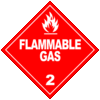 | Class 2.1: Combustible (flammable) Gases |
| 454 kg (1001 lbs) of any substance which is a gas under at 20°C (68°F) These substances have 101.3 kPa (14.7 psi) of pressure (a substance which has a boiling point of 20°C (68°F) or less at 101.3 kPa (14.7 psi)) which is ignitable at 101.3 kPa (14.7 psi) when in a mixture of 13 percent or less by volume with air; or has a flammable range at 101.3 kPa (14.7 psi) with air of at least 12 percent regardless of the lower limit. | |
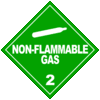 | Class 2.2: Combustible (flammable) and Non-toxic Gases |
| This class includes compressed gas, liquefied gas, pressurized cryogenic gas, compressed gas in solution, asphyxiate gas and oxidizing gas. Flammable, nontoxic gas means any substance which exerts in the packaging an absolute pressure of 280 kPa (40.6 psia) or greater at 20°C (68°F), and does not belong to the class 2.1 or 2.3. | |
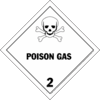 | Class 2.3: Toxic Gases |
| Toxic gases which’s known to be harmful to the human health and create hazards to health during transportation are gases 20°C or less and a pressure of 101.3 kPa (a substance which has a boiling point of 20°C or less at 101.3kPa and in the absence f adequate data on human toxicity, is presumed to be toxic to humans because when tested on laboratory animals it has an LC50 value of not more than 5000 ml/m3. | |
| Sınıf 3 :Flammable Liquids | |
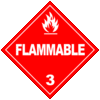 | A flammable liquid (Class 3) means a liquid having a flash point of not more than 60.5°C (141°F), or any substance in a liquid phase with a flash point at or above 37.8°C (100°F) that is intentionally heated and offered for transportation. |
| Class 4 :Flammable Solids | |
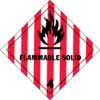 | Class 4.1: Flammable Solids |
| Flammable solids in their own form and they can cause a fire through friction and show a burning speed faster than 2.2 mm (0.087 inches) per second. Metal powders that can be ignited and react over the whole length of a sample in 10 minutes or less also fall into this class. Self-reactive substances, which are thermally unstable and that can undergo a strongly exothermic decomposition even without participation of air are also falling into this class. They are desensitized explosives that are in Class 1 or specifically authorized by the producer. | |
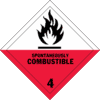 | Class 4.2: Spontaneously Combustible Solids |
| Spontaneously combustible substances are pyrophoric substances. These can ignite within five minutes after coming in contact with air or warm without an external ignition source. | |
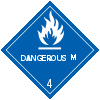 | Class 4.3: Pose danger when contacted with water |
| These substances become flammable or toxic when contacted with water. Hazard rate is greater than more than 1 liter per hour per 1 kg substance. | |
| Class 5 : Oxidizing Agents and Organic Peroxides | |
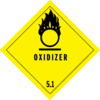 | Class 5.1: Oxidizing Agents |
| These substances by excreting oxygen cause or accelerate the combustion of other substances. | |
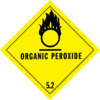 | Class 5.2: Organic Peroxides |
| An organic compound that contains oxygen in the form of bivalent (Class 5.2) "-O-O-" structure. These can be considered a derivative of hydrogen peroxide, where one or more of the hydrogen atoms have been replaced by organic radicals. | |
| Class 6:Toxic and Infectious (Germ Spread) Substances | |
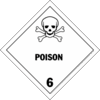 | Class 6.1: Toxic (Poisonous) Substances |
| Substances known as that can cause harm to people during transport are classified as toxic substances In addition, substances identified as toxic substances when tested on animals are counted as dangerous for the people included in this category. | |
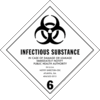 | Class 6.2: Infectious (germ spread) Substances |
| Infectious disease content substances known as have a pathogen agent or suspected to have a pathogen agent. Pathogens are microorganisms (such as bacteria, viruses or fungi) or are the other factors that can cause disease in humans or animals. | |
| Class 7: Radioactive Substances | |
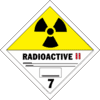 | Radioactive |
| They are substances with RADIOACTIVE YELLOW III (LSA-III) in the label ingredients. This tag is not used in some radioactive substances But need to bear the banner showing radioactivity even if this label is not used. | |
| Class 8: Corrosive Substances | |
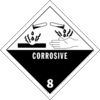 | Corrosive |
| They are substances that cause corrosion or skin thickness destruction of human skin in a certain period of time contact. Substances that have corrosive effect on steel or aluminum fall into this category. | |
| Class 9: Other Hazardous Substances | |
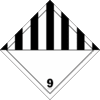 | Other Hazardous Substances |
| Presents a hazard during transportation but does not conform to any of the classes’ defined fall into this class. This class includes following agents: - Anesthetic or other type hazardous substances. These substances are causing discomfort to the flight crew or the ship's personnel to perform their duties. - Temperature degree increased substances, hazardous substances, residues harmful to human health or the substances with the risk of polluting sea. | |